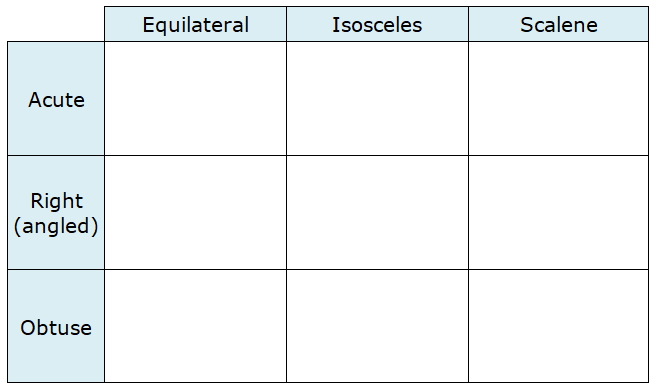Skip over navigation
What different types of triangle can you think of?

See how many you can name, then click on the buttons below to find out what some other children have said.
Edd said:
"There are four types of triangle: equilateral, isosceles, scalene and right-angled."
Fleur said:
"There are only three types of triangle. These are equilateral, isosceles and scalene. Right-angled triangles don't count because all right-angled triangles are also isosceles or scalene triangles."
Harmony said:
"You can name a triangle using either the sides or the angles of the triangle. Using the sides, you can have equilateral, isosceles and scalene triangles. Using the angles, you get right-angled, acute or obtuse triangles."
Which of these children do you agree with? Why?
We normally name triangles by thinking about the lengths of the sides, but in this activity we will also be naming triangles using their angles. How could we do this? What do you think an 'acute triangle' or an 'obtuse triangle' might look like?
Have a look at the grid below.

This grid is to help us think about different properties of triangles. For example, a triangle drawn in the box at the top on the left, should be able to be described as both acute (when thinking about its angles) and equilateral (when thinking about its sides).
Look at each space on the grid and try to sketch some different triangles to go in the box.
Can you sketch a triangle for every box in the grid? Why/why not?


Or search by topic
Number and algebra
Geometry and measure
Probability and statistics
Working mathematically
Advanced mathematics
For younger learners
Name That Triangle!
Age 7 to 11
Challenge Level 





What different types of triangle can you think of?

See how many you can name, then click on the buttons below to find out what some other children have said.
Edd said:
"There are four types of triangle: equilateral, isosceles, scalene and right-angled."
Fleur said:
"There are only three types of triangle. These are equilateral, isosceles and scalene. Right-angled triangles don't count because all right-angled triangles are also isosceles or scalene triangles."
Harmony said:
"You can name a triangle using either the sides or the angles of the triangle. Using the sides, you can have equilateral, isosceles and scalene triangles. Using the angles, you get right-angled, acute or obtuse triangles."
Which of these children do you agree with? Why?
We normally name triangles by thinking about the lengths of the sides, but in this activity we will also be naming triangles using their angles. How could we do this? What do you think an 'acute triangle' or an 'obtuse triangle' might look like?
Have a look at the grid below.

This grid is to help us think about different properties of triangles. For example, a triangle drawn in the box at the top on the left, should be able to be described as both acute (when thinking about its angles) and equilateral (when thinking about its sides).
Look at each space on the grid and try to sketch some different triangles to go in the box.
Can you sketch a triangle for every box in the grid? Why/why not?
You may also like
Cutting Corners
Can you make the most extraordinary, the most amazing, the most unusual patterns/designs from these triangles which are made in a special way?
Bracelets
Investigate the different shaped bracelets you could make from 18 different spherical beads. How do they compare if you use 24 beads?

